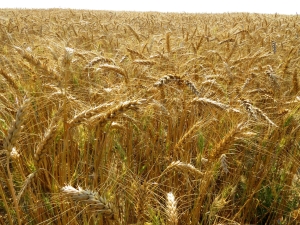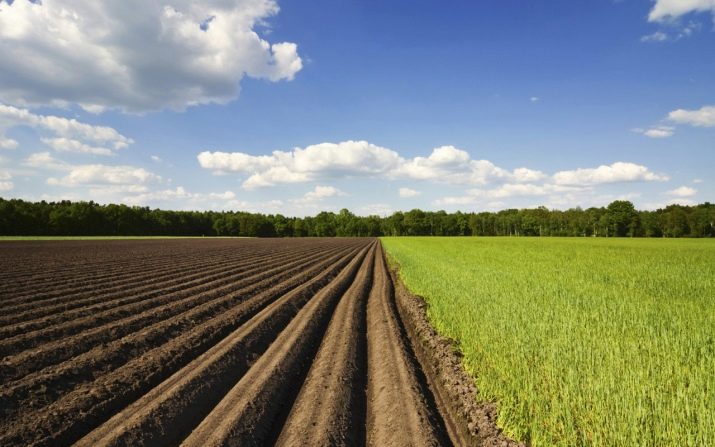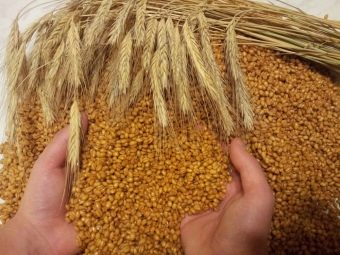The details of the process of growing wheat

On the territory of Russia are actively engaged in the cultivation of wheat. This product is used to make pasta, cereals, bakery products, and alcohol. The technology of cultivation of this type is complex and includes many features. Only with proper observance of all the subtleties in the process of growing wheat can you achieve a rich and high-quality harvest.
The main regions of cultivation in Russia
Despite the whimsicalness in the cultivation of wheat is not very demanding in weather conditions and climate. Due to this characteristic, the cultivation of this crop occurs on the territory of most regions of the state, however, some locations are suitable for growing grain more than others. The leaders in this area are the Krasnodar and Stavropol Territories. Together, these regions account for approximately 22% of the total share of wheat in the state.
The list of leaders also includes the following areas: Kursk, Saratov, Omsk, Voronezh, Volgograd. Altai Territory also belongs to them. Within the borders of the Urals and Siberia, they are also engaged in the cultivation of wheat, but to a lesser extent. These regions produce about 2-3% of the total amount of grain.
Features care culture
The ideal climate for wheat cultivation is continental, with mild, warm weather. As for the terrain, the steppe is more suitable for agricultural crops, given the fact that large areas are allocated for the cultivation of plants. Specialists from the agricultural sector have compiled a list of certain conditions for obtaining a stable and full-fledged harvest.
- In order for the seeds to germinate, the necessary temperature must be 1-2 degrees Celsius.
- To form the first shoots, the temperature should be slightly higher - from 3 to 4 degrees.
- Plant keeping the lowest possible temperature at -10 degrees, however, only for a short period.
- In order for the seeds to germinate, they need moisture from 50 to 60% of water based on the total weight of dry seeds.
- The soil moisture index is from 70 to 75% of the lowest moisture capacity.
These conditions are considered optimal and most favorable for growing plants. They must be familiar with before planting seeds. Culture does not tolerate high temperatures, which is why it will not be possible to get a rich harvest in regions with a hot climate.
At a temperature of about 40 degrees Celsius, in many species of a flap, the stomata begins to die.
Varieties
There are many varieties of wheat cultivated in Russia and other countries. All species are divided into two groups - spring and winter. To properly plant and grow a plant, you need to know the difference between these classifications. It is the time of sowing. Spring wheat must be sown from early spring to early summer. Winter wheat is sown from the middle of the last summer month until the end of October.
Also distinguish the following differences:
- The vegetation period of winter wheat is about 280 days, spring growth grows more actively, 100 days are enough for them;
- bakery qualities in spring species are higher;
- winter varieties are more demanding to the composition of the land, spring - to the conditions of cultivation;
- Spring wheat is drought tolerant, while winter varieties tolerate better cold weather and extreme weather changes.
Light mode
A significant factor in the cultivation of culture is light day. The guarantee of a rich harvest is a long sunny day, with plenty of natural light. With its deficiency, many internodes may begin to form. In this case, the tillering sheet of the plant forms too close to the surface of the soil.These factors adversely affect the resistance of the crop to insects, pests and weather conditions. Also decreases the stamina of the plant.
Soil composition
Experienced agronomists are serious about choosing a site for planting. The composition of the soil is also important for obtaining a rich, top-quality crop. Experts point out that wheat feels great on sandy and loamy (sod-podzolic) soils. If it is not possible to choose one of the above options, make a choice in favor of peat bog lowland soils.
Indicator soil for the cultivation of crops:
- minimum pH value - 5.8;
- the composition of humus - from 1.8;
- K2O and P2O5 - at least 150 milligrams per kilogram of land.
Predecessors
For a bountiful harvest, it is recommended to regularly change the planting site. Re-sowing at one site comes to a significant decline in yield. This happens due to the depletion of soil composition and disease. The technology of cultivation of this crop includes mandatory compliance with the rules of crop rotation. For planting wheat is ideal for areas where previously grew potatoes or legumes. Experts state that the land on which grass or cruciferous vegetables used to grow was also suitable.
Top dressing
The required number of additional nutrients, as well as their volume, is calculated depending on the composition of the soil and the region of growth. Also, be sure to consider the type of crop. Nitrogen and phosphate compounds are used for fertilizing wheat of winter type. Before sowing, a significant part of phosphate-potassium fertilizers is introduced into the soil. Feeding in a small amount is added in the fall or early March using the root technique. Fertilizer in spring stimulates the growth of wheat. And at this time the plant special needs phosphorus, nitrogen, and also sulfur.
Spring wheat varieties are fertilized during tillering. At the beginning of growth, in the early stages, this species is practically insensitive to mineral fertilizers. Excellent results can be achieved using nitrogen supplements. Also, experts use phosphorus mixtures. In the period of earing make potassium compounds.
How to grow at home?
Given the popularity of the trend of a healthy lifestyle, many are starting to grow wheat at home. Sprouted grains have many positive qualities and are considered an important part of the diet of a healthy person. Knowing the method of cultivation, to achieve the desired result is easy.
For growing plants at home will need the following.
- Quality grains that have not been processed using chemical compounds. It is recommended to choose winter wheat.
- It is necessary to prepare a tray made of glass or plastic, metal will not work. Plastic containers must be made from food raw materials. Also used pallets. If there is no tray, use ordinary glass jars.
- The humidifier will help to achieve the expected result, it is actively used by those who are serious about the process of growing plants at home and are constantly engaged in this. The most ordinary model will be quite enough.
- Do not do without clean and fresh water, heated to room temperature.
- If cultivation occurs by sowing in the ground, it is necessary to prepare the soil or compost.
How to choose grains?
In specialized stores you can find wheat, which is ideal for germination at home. The certified product is labeled accordingly, which confirms its quality. If you want to save money, you can buy grain from farmers. In this case, it is very difficult to assess the quality of the product. Visually check whether the seeds were treated with chemicals or not, it is impossible. Before buying, be sure to evaluate the state of the product visually.Pay attention to the size of the seeds, as well as their integrity. Ideal - smooth and dry kernels without mold and other defects. Also, they must be the same size.
Harvesting seeds yourself
Those who adhere to a healthy lifestyle and are engaged in growing wheat at home instead of buying grain, harvest them on their own. Newbies in this business are wondering how many grains grow from a single grain of wheat. From one seed you can grow a full spikelet. In one ear several dozen grains. When self-procured seed you can be completely confident in its quality and safety.
If the growing conditions are violated, even the best quality seeds can start to sweat, swelling in water. If you notice mold on the grains, throw them away immediately. It is impossible to germinate such material. The cultivation process depends on the cultivar; however, experts single out one rule for all types of wheat - it is better to under-grain a little in the water to prevent the formation of mold than to overdo.
Growing up
After buying the first thing you need to soak the grain in the water. Before starting it is important to measure the amount of seed needed. If you use a large tray, the size of which is approximately 40x40 centimeters, two glasses of wheat will be quite enough. Seeds should cover the bottom of the tray or tray with an even and uniform layer.
Next, the grains are thoroughly washed with cool and clean water. After this, the soaking process takes place in a bowl, using filtered water at room temperature. It is easy to calculate the volume of liquid, it should be three times larger than the volume of seed. Wheat is covered with a lid and left in water for about 10 hours. After the first soaking time, the procedure must be repeated, adhering to the above description with one difference - use water cooler for the second and third time. After 10 hours do the procedure for the last time.
If done correctly, you will notice tiny roots on the seeds. The material is washed. If there are holes in the bottom of the container that you will use to grow, the bottom should be covered with paper towels. They should be white, without patterns and various flavors. Otherwise, roots can grow through them.
Earth or compost of organic origin is poured with a small layer - 5 centimeters. In the process of home cultivation, fertilizing cultures are not used. Grains are distributed on the ground evenly.
Digging in the seeds completely is not necessary, just enough to gently press to the ground. For irrigation, use only clean water. Moisturize soil over the entire plane.
How to germinate without land?
At home, for practicality and convenience, you can use the method of sprouting a crop without soil. You will need a tray or tray with a solid bottom and gauze. The textile material is folded in several layers, laid on the bottom, spreading seed over the top, after which the grains are covered with several more layers of gauze.
In the process of growing carefully moisten gauze, but do not fill it with water entirely, otherwise the mold can not be avoided. Tare with wheat is covered with a cloth or wet newspapers. Check the condition of the grain every day, do not let it dry. Fabric material or newspapers that cover the tray should be moistened regularly. 4 days after disembarking, remove the paper and fabric that cover the top of the structure. Watering should be carried out once a day.
General recommendations
Use the recommendations of experts to get the wheat harvest as soon as possible.
- Make sure that the grains do not fall into the direct rays of the sun, but you can not keep them in a dark room. Ideal conditions are diffused light.
- The optimal temperature indicator - from 22 to 24 degrees Celsius.
- Wheat loves high humidity. If the house has dry air - use special humidifiers.
- Sprouts should appear after two days. Otherwise, seedlings can be thrown away. Try again, carefully adhering to the agrotechnical, or use another seed, perhaps you have a poor quality lot.
See the next video for details on the cultivation of wheat.




































